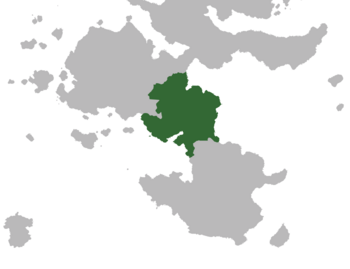Shffahkian Empire
Shffahkian Empire Empire Sfaquien Impero Sfachiano | |||||||||||
|---|---|---|---|---|---|---|---|---|---|---|---|
| 1802–1848 | |||||||||||
| Motto: Sempre Risoluto "Always Resolute" | |||||||||||
| Anthem: Cara Sfachia "Dear Shffahkia" | |||||||||||
 The Shffahkian Empire at its largest territorial extent before the Shffahko-Kirvinan War, 1833-1941 (dark green) | |||||||||||
| Capital | Port-Réel | ||||||||||
| Common languages | Cristenese, Lysian | ||||||||||
| Religion | Aroman Catholicism | ||||||||||
| Government | Constitutional monarchy | ||||||||||
| Emperor | |||||||||||
• 1802-1848 | Eustace I | ||||||||||
| Premier | |||||||||||
• 1811–1823 | Gasperi Deltuorno (office created) | ||||||||||
• 1841–1848 | Jean-Patrique Lecerf (last) | ||||||||||
| Legislature | General Assembly | ||||||||||
| Senate | |||||||||||
| Chamber of Peers | |||||||||||
| Historical era | 19th century | ||||||||||
| 7 May 1789 | |||||||||||
• Proclamation of the Shffahkian Empire | 12 February 1802 | ||||||||||
• Accession of Eustace I | 25 March 1802 | ||||||||||
• Adoption of the November Constitution | 7 December 1811 | ||||||||||
| 13 June 1848 | |||||||||||
| 15 November 1848 | |||||||||||
| Population | |||||||||||
• 1808 | 3,620,000 | ||||||||||
• 1839 | 7,500,000 | ||||||||||
• 1846 | 15,930,479 | ||||||||||
| Currency | Terent | ||||||||||
| |||||||||||
| Today part of | |||||||||||
The Shffahkian Empire (Lysian: Empire Sfaquien / Empire Sfakien, Cristenese: Impero Sfachiano) was a 19th-century nation that existed from its proclamation in 1802 to slightly past the death of its one, and only, emperor in 1848. It was mostly located in Central Aurelia. The Shffahkian Empire was a Representative Constitutional Monarchy under Emperor Eustace I. The Empire traces its origins to colonies of Limonaian City-States formed between 1498 and 1712 as well as the Lysian colony of Nova Lilium officially formed in the Chartre des Grands in 1691. Following the Shffahkian Revolution and the period of unrest thereafter, the Dassie Front led by General Eustache Eugène de Caldofondo-Bouvèron won a series of military victories, uniting the lands of Nova Lilium. Later in 1796, the Dassie Front now called the Continental Army would go on to declare war and win against the Limonaian Empire and the Confederation of Aurelian City-States in the First Shffahko-Limonaian War. Victory against the Limonaian Empire resulted in the annexation of the CCSA and other Limonaian holdings in Aurelia into the Shffahkian Empire, which was declared shortly thereafter on February 12, 1802. Eustache Eugène de Caldofondo-Bouvèron was chosen to be the emperor of the newly declared empire, ascending to the throne in March of the same year. Upon his accession to the throne, Eustache I became the emperor of an ethnically-diverse, yet sparsely populated, country.
Eustache I defined himself as an enlightened ruler, making great promises of democracy and equality upon his ascension to the throne. From its proclamation in 1802 to 1805, the Shffahkian Empire was a de facto absolute monarchy. In 1806, the Senate and Chamber of Peers were created by imperial decree with the goal of drafting a constitution, however, disagreements arose between the emperor and Senate over the role of the monarch which would be solved five years later when the November Constitution was adopted in December 1811. Through the constitution, the Shffahkian populace was guaranteed equality before the law, freedom of speech and respect for the citizens' civil rights although, slaves and women were faced with certain legal restrictions. Through Emperor Eustache I's reforms, Shffahkia experienced political stability and great economic prosperity.
From 1820 onward, the Shffahkian Empire began enacting a series of policies aimed towards expansion and supposed civilization of Aurelia called Destinée Démontrée. Although Shffahkia expanded into almost every direction, the settlement of the West, where modern-day Dasdaine is, and of the South were particularly encouraged. Destinée Démontrée led Shffahkia to a series of wars and conflicts, most of which it won, leading to Shffahkia becoming the dominant political power of Aurelia until the mid-1800s. Kirvinan opposition towards Shffahkia would lead the latter to declare war, leading to the Shffahko-Kirvinian War. Although initially successful, the war would take a disastrous turn when Eustache I died in Kirvina on campaign, later followed by his eldest son and successor to the throne, Eustache II. The death of the heir apparent meant that the eldest daughter of Eustache I, Marianne, would take the throne. The Premier, Jean-Patrique Lecerf, and the majority of senators did not want a woman on the throne, especially when they were dealing with the consequences of Eustache I's ill-advised war. As a result, the Senate abolished the monarchy declaring the beginning of the First Shffahko-Republic on November 15, 1848, with Jean-Patrique Lecerf as its first president ending the Shffahkian Empire.

